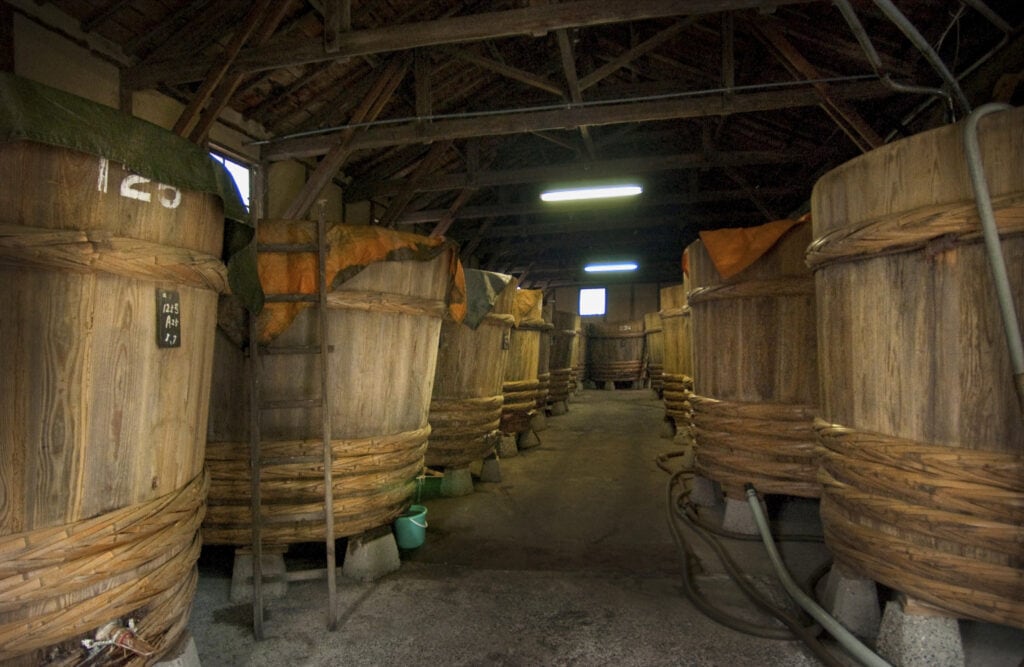Whereas a few decades ago the brown Maggi bottle was found in almost every German household as a kind of universal seasoning, soy sauce has been found in every Japanese household for centuries. Soy sauce is an integral part of Washoku, the Japanese cuisine. However, there are significant differences that make soy sauce a very special seasoning, which is now also gaining wider and wider attention in the West.
So there is not just ONE soy sauce, but there are many different types - and this has been the case for centuries.
Historical development of soy sauce in Japan
Shōyu (soy sauce) is first mentioned in Japan in the 1597 book 易林本 節用集 (Ekirinbon Setsuyoushu), but it has been around much longer.
The first precursors can be traced as early as the 2nd century, but the main development probably took place between the 3rd and 5th centuries.
Initially, various meat, fish and salt products were fermented to create a spicy sauce. Later, soy was added and over time soy became the main ingredient. In the 6th or 7th century, it probably came to Japan and the typical Japanese soy sauce developed (there are different sources on this).
Various soy sauces in Japan
While for many years there was only "one soy sauce" in people's minds in Germany, people in Japan naturally know a much wider range of differently brewed soy sauces for different purposes.
Of course, soy sauce is used with it, Sushi & Sashimi to season (please do not bathe sushi!), it is an important ingredient for shoyu ramen, and soy sauce is also indispensable for numerous other dishes in Japan.
Here is a brief overview of a few typical Japanese soy sauces:
Koikuchi Shōyu (濃口醤油)
About 80% of the soy sauce produced in Japan is Koikuchi Shōyu, which is the so-called dark soy sauce.
Usukuchi Shōyu (淡口醤油)
The lighter Usukuchi Shōyu originates from the Kansai region (around Ōsaka) and accounts for about 10% of Japanese production. It is saltier than Koikuchi Shōyu. The color and fragrance are more restrained and you can sense the flavor of the original ingredients more.
Tamari Shōyu (溜醤油)
This soy sauce without wheat content is brewed mainly in the Chūbu region, the central area of Japan's main island of Honshū. It is more commonly used for sashimi, but it also gives many sembei (rice crackers) their attractive, strong reddish color.
Because Tamari is brewed without wheat, Tamari does not contain the gluten of wheat like other soy sauces and is therefore often used as a gluten-free alternative to other soy sauces.
In our restaurant sansaro in Munich we offer as a wheat-free soy sauce alternative for an extra charge the Ark Cedarwood Tamari an.
Gen en Shōyu (減塩醤油)
This is a dark, reduced-salt soy sauce.
Saishikomi Shōyu (再仕込醤油)
Often referred to as "sweet," this soy sauce is produced predominantly in parts of Kyūshū and Yamagata Prefecture.
The peculiarity of this soy sauce is that in the brewing process is not water, but already finished soy sauce. That is why it is said that Saishikomi Shōyu is brewed twice. It is very flavorful and is used almost exclusively at the table for sashimi, sushi or tofu. Of course, the elaborate production process also means that it only holds an extremely small share of the market, at around 1%.
Shiro Shōyu (白醤油)
This soy sauce, made almost exclusively from wheat, originally comes from the Hekinan district in Aichi Prefecture. It is amber in color and has a sweetness that is easy to feel, making it particularly suitable for "delicate" dishes such as chawanmushi (steamed egg custard).
Amakuchi Shōyu (甘口醤油)
Coming from Toyama Prefecture, Amakuchi Shōyu is characterized by a sweet and mild flavor, making it particularly suitable for enhancing the taste of fish.
Tosa Shōyu (土佐醤油)
Tosa soy sauce is the name given to a soy sauce that has been refined in a sushi restaurant for optimal sushi and sashimi enjoyment.
To do this, the soy sauce with the addition of katsuo-bushi (鰹節, dried bonito flakes) and mirin. (味醂, sweet sake made from glutinous rice), boiled sake and so on.
Japanese restaurants, of course, in the best case, have their own original Tosa-Shōyu, which is made according to their own recipes. It is characterized by its mild aroma and slightly thickened flavor and tastes good not only with Sashimi, but also to hiyayakko (冷奴 cold tofu), atauage-dōfu (厚揚げ豆腐, thick fried tofu), yu-dofu (湯豆腐, boiled tofu) and other dishes.
By the way, a real tosa soy sauce is therefore never vegetarian.
"Tosa" is the former name of present-day Kochi Prefecture. In the Edo period (1603-1867), a master katsuo-bushi maker named "Tosa no Yoichi" (土佐の余市) introduced his method to Edo (present-day Tōkyō), and chefs began using bonito flakes and soy sauce together, which is considered the origin of Tosa-Shōyu.
The name "Tosa" is often associated with Japanese cuisine, because Tosa is considered a very important place for the production of bonito flakes, which play a central role in Japanese cuisine, especially in the preparation of dashi "soup stock".
Dashi, based on algae and bonito flakes, is the central building block of the classic japanese cuisine.
Different soy sauce production methods in Japan
The characteristics of the various soy sauces described here are conditioned by the fermentation time, ingredients and technology. A distinction is also made between traditional and industrial production.
Natural brewing method of soy sauce: Honjōzō
In the natural brewing method (Honjōzō, we already know the term from the various Sake categories), soybeans are steamed while the grain (wheat) is roasted and then crushed/ground. After inoculation with Kōji, this produces Shōyu kōji (dry mash) within three days. Water and salt are then added to create moromi, which now ferments in large vats or tanks for between 6 to 8 months before large presses are used to extract the soy sauce.
A process that, remarkably, has also been the Sake production resembles.
Very special soy sauces even mature for more than 5 years before they, too, are pressed to obtain a very special soy sauce.
Industrial production of soy sauce shortens the ways
In industrial production, on the other hand, soy protein is dissolved with water and soy flour and hydrolyzed with hydrochloric acid. The mass is mixed with yeasts and lactic acid bacteria and so the production takes only a few days. In addition, flavors, sugar and preservatives are also added.
Distinctions between industrially and naturally produced soy sauce
But how can one distinguish now? You can use your own nose, for example. Soy sauce has a slightly sweet scent and a delicate aroma, while industrially produced soy sauce smells very intense and sometimes an almost chemical odor can be perceived.
Or you can use your eyes. The easiest thing to do, of course, is to look at the ingredient list on the package, but you can also just put a wooden stick in the sauce. Naturally brewed soy sauce will drip evenly from the tip, while industrially produced soy sauce will stick to the tip of the stick almost like sticky drops of honey.
Japanische Sojasauce aus Japan - oder aus Europa?
Interessant, aber wenn man es weiss auch einleuchtend: japanische Sojasauce der Marke Kikkoman für den europäischen Markt, gebraut in den Niederlanden, schmeckt anders als die gleiche japanische Sojasauce der Marke Kikkoman, gebraut in Japan – unsere Küche stellen bei der europäischen Version einen etwas weniger weichen, leicht metallischen Geschmack fest.
Wenn man sich aber in Erinnerung ruft, was wir aus der Beschäftigung mit dem japanischen Wasser im Kontext von Sake-Brauen wissen, ist es ganz logisch: durch das weiche japanische Wasser als Grundlage muss eine in Japan gebraute Sojasauce ganz anders schmecken – auch bei genau gleicher Rezeptur.
Conclusion: soy sauce a seasoning with variety and depth
Even though soy sauce is now almost a "basic ingredient" in Germany, unfortunately few know about its diversity.
Maybe this little article will make you want to not just buy the "standard bottle" of soy sauce from the supermarket, but also try something a light soy sauce or even a specialty made in manufactories. By the way, there are even now soy sauce specialties made in German manufactories.
In any case, you should make sure that the soy sauce was made in the traditional process, for which it had to store at least two years. Nowadays, this is not the case with every soy sauce, interestingly enough, not even with every one that is sold as "organic" just in Germany.
This makes any naturally produced soy sauce a real cultural asset, especially good, of course, if it is a Organic Shoyu as we have been doing since 2007 in the Restaurant sansaro insert







